Vena cava and aortic smooth muscle cells express transglutaminases 1 and 4 in addition to transglutaminase 2
- PMID: 22307675
- PMCID: PMC3330795
- DOI: 10.1152/ajpheart.00918.2011
Vena cava and aortic smooth muscle cells express transglutaminases 1 and 4 in addition to transglutaminase 2
Abstract
Transglutaminase (TG) function facilitates several vascular processes and diseases. Although many of these TG-dependent vascular processes have been ascribed to the function of TG2, TG2 knockout mice have a mild vascular phenotype. We hypothesized that TGs besides TG2 exist and function in the vasculature. Biotin-pentylamide incorporation, a measure of general TG activity, was similar in wild-type and TG2 knockout mouse aortae, and the general TG inhibitor cystamine reduced biotin-pentylamine incorporation to a greater extent than the TG2-specific inhibitor Z-DON, indicating the presence of other functional TGs. Additionally, 5-hydroxytryptamine-induced aortic contraction, a TG-activity-dependent process, was decreased to a greater extent by general TG inhibitors vs. Z-DON (maximum contraction: cystamine = abolished, monodansylcadaverine = 28.6 ± 14.9%, and Z-DON = 60.2 ± 15.2% vehicle), providing evidence for the importance of TG2-independent activity in the vasculature. TG1, TG2, TG4, and Factor XIII (FXIII) mRNA in rat aortae and vena cavae was detected by RT-PCR. Western analysis detected TG1 and TG4, but not FXIII, in rat aortae and vena cavae and in TG2 knockout and wild-type mouse aortae. Immunostaining confirmed the presence of TG1, TG2, and TG4 in rat aortae and vena cavae, notably in smooth muscle cells; FXIII was absent. K5 and T26, FITC-labeled peptide substrates specific for active TG1 and TG2, respectively, were incorporated into rat aortae and vena cavae and wild-type, but not TG2 knockout, mouse aortae. These studies demonstrate that TG2-independent TG activity exists in the vasculature and that TG1 and TG4 are expressed in vascular tissues.
Figures
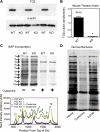

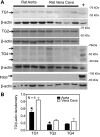
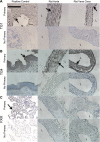



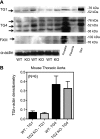
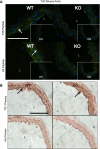
Similar articles
-
Transglutaminase activity is decreased in large arteries from hypertensive rats compared with normotensive controls.Am J Physiol Heart Circ Physiol. 2015 Mar 15;308(6):H592-602. doi: 10.1152/ajpheart.00402.2014. Epub 2015 Jan 16. Am J Physiol Heart Circ Physiol. 2015. PMID: 25599570 Free PMC article.
-
Transglutaminases Are Active in Perivascular Adipose Tissue.Int J Mol Sci. 2021 Mar 5;22(5):2649. doi: 10.3390/ijms22052649. Int J Mol Sci. 2021. PMID: 33808023 Free PMC article.
-
Tissue Transglutaminase Modulates Vascular Stiffness and Function Through Crosslinking-Dependent and Crosslinking-Independent Functions.J Am Heart Assoc. 2017 Feb 3;6(2):e004161. doi: 10.1161/JAHA.116.004161. J Am Heart Assoc. 2017. PMID: 28159817 Free PMC article.
-
Recent Progress in the Development of Transglutaminase 2 (TGase2) Inhibitors.J Med Chem. 2017 Jan 26;60(2):554-567. doi: 10.1021/acs.jmedchem.6b01036. Epub 2016 Nov 21. J Med Chem. 2017. PMID: 28122456 Review.
-
Transglutaminases and disease: lessons from genetically engineered mouse models and inherited disorders.Physiol Rev. 2009 Jul;89(3):991-1023. doi: 10.1152/physrev.00044.2008. Physiol Rev. 2009. PMID: 19584319 Review.
Cited by
-
Off-target effects of protein tyrosine phosphatase inhibitors on oncostatin M-treated human epidermal keratinocytes: the phosphatase targeting STAT1 remains unknown.PeerJ. 2020 Aug 14;8:e9504. doi: 10.7717/peerj.9504. eCollection 2020. PeerJ. 2020. PMID: 32864202 Free PMC article.
-
Probing tissue transglutaminase mediated vascular smooth muscle cell aging using a novel transamidation-deficient Tgm2-C277S mouse model.Cell Death Discov. 2021 Jul 29;7(1):197. doi: 10.1038/s41420-021-00543-8. Cell Death Discov. 2021. PMID: 34326316 Free PMC article.
-
Transglutaminase inhibitors attenuate vascular calcification in a preclinical model.Arterioscler Thromb Vasc Biol. 2013 Jan;33(1):43-51. doi: 10.1161/ATVBAHA.112.300260. Epub 2012 Nov 1. Arterioscler Thromb Vasc Biol. 2013. PMID: 23117658 Free PMC article.
-
Biochemical Characterisation of Human Transglutaminase 4.Int J Mol Sci. 2021 Nov 18;22(22):12448. doi: 10.3390/ijms222212448. Int J Mol Sci. 2021. PMID: 34830327 Free PMC article.
-
Long term gluten consumption in adults without celiac disease and risk of coronary heart disease: prospective cohort study.BMJ. 2017 May 2;357:j1892. doi: 10.1136/bmj.j1892. BMJ. 2017. PMID: 28465308 Free PMC article.
References
-
- Bailey CD, Johnson GV. The protective effects of cystamine in the R6/2 Huntington's disease mouse involve mechanisms other than the inhibition of tissue transglutaminase. Neurobiol Aging 27: 871–879, 2006. - PubMed
-
- Bakker EN, Buus CL, Spaan JA, Perree J, Ganga A, Rolf TM, Sorop O, Bramsen LH, Mulvany MJ, Vanbavel E. Small artery remodeling depends on tissue-type transglutaminase. Circ Res 96: 119–126, 2005. - PubMed
-
- Bakker EN, Pistea A, Spaan JA, Rolf T, de Vries CJ, van Rooijen N, Candi E, VanBavel E. Flow-dependent remodeling of small arteries in mice deficient for tissue-type transglutaminase: possible compensation by macrophage-derived factor XIII. Circ Res 99: 86–92, 2006. - PubMed
-
- Bakker EN, Pistea A, VanBavel E. Transglutaminases in vascular biology: relevance for vascular remodeling and atherosclerosis. J Vasc Res 45: 271–278, 2008. - PubMed
-
- Baumgartner W, Golenhofen N, Weth A, Hiiragi T, Saint R, Griffin M, Drenckhahn D. Role of transglutaminase 1 in stabilisation of intercellular junctions of the vascular endothelium. Histochem Cell Biol 122: 17–25, 2004. - PubMed
Publication types
MeSH terms
Substances
Grants and funding
LinkOut - more resources
Full Text Sources
Molecular Biology Databases
Research Materials
Miscellaneous

